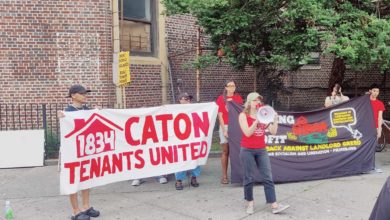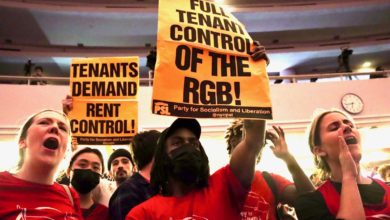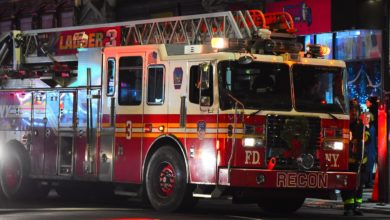A PSL delegation recently visited Tent City, a homeless community in Ontario, Calif. The delegation included Stephen Hinze, the author of this report and candidate for Los Angeles County Board of Supervisors, 5th District; Lucilla Esguerra, candidate for California State Assembly, 48th District; and Crystal Kim, candidate for the Council of the District of Columbia (at-large). Click here to learn more about the PSL candidates.
|
Tent City, as this community is known, began in summer 2007 when Ontario mayor and local pastor Paul Leon designated the area next to the airport as a “rest area.” The police started picking up the homeless off the streets and relocating them to this so-called “rest area.”
As the banks kick people out of their homes, the struggle for the poor and working class intensifies. Because of the rising number of foreclosures, Tent City’s population grew from 20 to 30 homeless people to over 500. New residents arrived from all over—Los Angeles, Florida and even North Carolina. Ontario’s foreclosure rate ranks third in the nation. (BBC News, March 14)
The expansion of Tent City saw dozens of cops and code enforcement officers begin entering the camp and asking for identification. They claimed that they invaded because of health and safety issues caused by the increasing number of people.
The police issued residents colored wristbands. A blue wristband meant the person was from Ontario and could remain in the camp. An orange wristband indicated a person must provide proof of residency to avoid ejection. A white wristband meant a person had one week to leave.
Those identified as having ties to Ontario are issued an identification card that has an expiration date of June 2008. Yet, what happens after June? No one has been told whether residents will get to stay or whether Tent City will be closed for good at that point.
The people of Tent City have undergone unimaginable harassment. Hundreds of people have been forced out and many more tagged with white wristbands will soon have no place to go.
For those who stay, it will become much like a prison—a fence being built around it will provide only one entrance and exit, and a curfew will be instituted. If residents are not in the camp by 10 p.m. they will not be allowed back in. If they do make the curfew, they must stay inside the camp until the gates are opened again at 6 a.m.
These repressive new rules and regulations do nothing to address the core issues underlying the plight of Tent City residents: the need for affordable housing, health care, quality education and job training.
Living conditions degrading, dangerous
The residents of Tent City face not only repression and harassment but also horrific living conditions.
Hygiene is a major issue. There are about ten portable toilets, which are at best superficially cleaned a few times a week. There is one shower for the whole camp and it runs only cold water.
In addition, since July the residents have had to battle heavy rains and the strong Santa Ana winds. Large commercial airplanes fly overhead constantly, polluting the air with noise and jet fuel. Loud freight trains go by at all hours of the night.
Ernesto, a resident of Tent City, lost his home to a foreclosure. “I lost my daughter, my daughter died. She was sick and we could not pay our medical bills and then we lost our home,” he said. “I was laid off from my job as a teacher and I never thought I would find myself homeless.”
“I have been kicked out several times, but I continue to return,” told Patty, another Tent City resident.
There are many women in Tent City, but you will not see any children. That is because no one under the age of 18 is allowed in the camp. Certainly, among the hundreds of Tent City residents, are many parents of young children—one can only wonder where their kids were taken.
Every year, 3.5 million people in the United States are homeless for all or part of the year. As of October 2007, 17.4 million houses stood vacant (MSN Money, Oct. 4, 2007). People in need of homes, homes in need of people—an avoidable tragedy brought to us courtesy of the profit system
Such contradictions are the essence of capitalism. The war has officially cost over half a trillion dollars—a figure that is rising at a rate of $450 million per day, or $5,000 per second. A fraction of that sum could be used to provide homes to those who need them, yet it is being spent on the war.
We must continue to fight against the landlords and real estate speculators who push people onto the streets so they can maximize profits. The needs of people, including housing, can only be met once the profit system has been eradicated.







